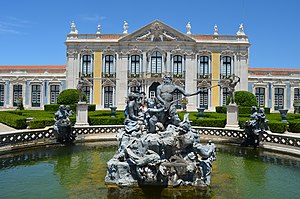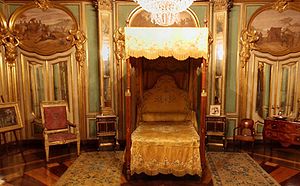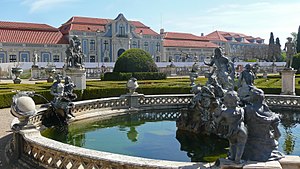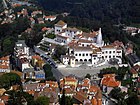Palace of Queluz

The Palace of Queluz (
Work on the palace began in 1747 under Portuguese architect
One wing of the palace, called the Queen Maria I Pavilion, built by
Architecture and history

Queluz's architecture is representative of an extravagant period of Portuguese culture, which followed the discovery of Brazilian gold in 1690.[4] From the beginning of the 18th century, many foreign artists and architects were employed in Portugal to satisfy the demands of the newly enriched aristocracy; they brought with them classical ideas of architecture which derived from the Renaissance. In its design, Queluz is a revolt against the earlier, heavier, Italian-influenced Baroque, which preceded the Rococo style throughout Europe.[4]
Comparisons with the far larger, and more Baroque, Versailles are unwarranted; Versailles is referred to as having "an aura of majesty" and was built and dedicated to exhibit in stone "all the glories of France,"
On the accession to the throne of Queen Maria I in 1777, Pombal was dismissed by the new Queen. She and Pedro III ruled jointly in his place; using the partially completed Queluz as a retreat from affairs of state in much the same way that

The site chosen for the proposed summer retreat was in a secluded hollow.
The architect Mateus Vicente de Oliveira had trained under Ludovice of Ratisbon and Jean-Baptiste Robillon[10] during the construction of the royal Palace of Mafra and its monastery. The larger, sombre, and classical Mafra does not appear to have influenced the design for Queluz, which is in a lighter, more airy style.[1]
Work began in 1747, and continued rapidly until 1755, when it was interrupted by the Great earthquake of 1755, after which the labourers were more urgently required for the reconstruction of Lisbon. However, the earthquake proved to be a catalyst, as the urban rebuilding process stimulated the development of the arts in Portugal.[4] The subsequent architecture of Queluz was influenced by new ideas and concepts. When work recommenced in 1758, the design was readapted for fear of another earthquake. Thus, later work on the palace took the form of low, long buildings that are more structurally stable than a single high block. As a result, when viewed from a distance, the palace resembles a series of long enfilades linked by higher pavilions, rather than one single construction.[11]
Exterior


The public
Oliveira was directly responsible for the "Ceremonial Façade" of the "corps de logis", the rectangular block which forms the nucleus of the palace, and some of the interior courtyards. His former tutor, the Frenchman Jean-Baptiste Robillon, was in charge of the gardens, many buildings, and the Rococo interiors. He in turn was assisted by Jean-Baptiste Pillement and other French and Portuguese artists. The "Ceremonial Façade" is the best-known view of the palace. With classical proportions, it is externally decorated by travertine rendering and delicately carved cartouches over the windows. It has been described as a "harmonious example of Portuguese Baroque".[9] This façade with its single-storey flanking wings forms a three-sided courtyard containing the "Hanging Garden"—so called because like the Hanging Gardens of Babylon it is on a raised terrace (see key 5).[citation needed]
The second major part of the palace is the great western wing, known as the Robillon wing or Robillon Pavilion, which illustrates better than any other the excesses of Baroque and Rococo architecture (see key 9). Completed in 1779, it has a
The Robillon wing contains an entrance to the palace reached by flights of ingeniously designed graduated steps. Their design creates an illusion of a longer and higher perspective, centred on a corner of a terrace because of exigencies of the site, and divided mid-flight so as not to lead the eye and footstep towards an angle of the colonnade beyond. The steps are adorned with elaborate statuary (see key 11). The bays of the façade are stuccoed rose-pink, contrasting with the motifs and pilasters in natural stone (see illustration).[citation needed]
In 1760, Pombal arranged for King José I's brother, Pedro of Braganza, to marry José I's daughter, Maria; heiress to the throne. Pombal then encouraged the couple to live with their children in the unfinished palace at Queluz, away from the seat of government. It had been a favourite retreat of the couple and was their principal home before Maria I's accession. Further additions were made to reflect the palace's elevation from country retreat to royal palace. However, the Queen dismissed Pombal on her accession. She felt that, as a ruling monarch, she did not have time to while away her hours in the country. Pedro III interfered little in affairs of state, preferring to spend his time on religious matters and hunting.[13]
By the time of Pedro III's death in 1786, all of the interior work had been completed.[14] However, after her husband's death, the Queen's mental health began to dramatically deteriorate. By 1794, she and her court took up official, full-time residence at Queluz so that the Queen could be hidden from the view of her subjects. Her eldest son, future King João VI, was then appointed Regent and ruled in her stead from Lisbon at the Palace of Mafra.[15]
In 2004, the World Monuments Fund began a program to restore the lead sculptures by British sculptor John Cheere, as well as some of the other features of the garden. The project is ongoing.
five-stage campanile with floral finials in the town square beyond the cour d'honneur. |
 |
Interior
The interior of the palace received no less attention to detail and design than the exterior. French artisans were employed to decorate the rooms, many of which are small; their walls and ceilings painted to depict allegorical and historical scenes. Polished red bricks were frequently used as flooring, to give a rustic appearance, as well as to help keep rooms cooler in hot weather.[1] The many tall pavilions, which link the various lower wings of the palace, allow for a series of long, low rooms, broken by higher and lighter rooms. One predominant feature of the interiors are the polychrome azulejos glazed tiles, often in a chinoiserie style, with blues and yellows contrasting with muted reds. Other materials used throughout the interior include stone imported from Genoa; woods from Brazil, Denmark and Sweden; and coloured marbles imported from Italy.[17] Many of the palace's rooms were severely damaged by fire in 1934, and much was lost.
The state apartments
Sala das Mangas
The Sala das Mangas (the only room in the
The Music Room
The Music Room, which follows the Sala dos Embaixadores, is decorated with gilded and painted wood and was redesigned in 1768. The
 |
Maria I hangs above the piano. |
The Ball Room
The Ball Room, the last of the palace's three largest rooms,
Sala dos Embaixadores
The Sala dos Embaixadores (Hall of Ambassadors), sometimes called the throne room or the Hall of Mirrors, was designed by Robillon in 1757 and is one of the largest reception rooms in the palace.[18] This long, low room has a ceiling painted by Francisco de Melo, which depicts the Portuguese royal family attending a concert during the reign of Queen Maria I. The room is extremely wide and light, spanning the full width of the palace, with tall windows on both sides. Between each window is a semi-circular gilt console table, above which are pier glasses adorned with crystal sconces. The throne dais, set in an apse, is flanked by gilded and mirrored columns, and the floor is a chequer board pattern of black and white marble tiles.[22]
Schloss Nymphenburg.[18] |
 |
The Chapel
During the occupancy of the palace by Queen Maria I and King Pedro III, the chapel was central to the daily routine of their court. It was no coincidence that the chapel was the first part of the palace to be completed and was
Following Pedro III's death, the Queen abandoned all festivities at the palace and state receptions assumed the air of religious ceremonies.
The chapel beneath its large onion dome is dark, cavernous, and decorated in carved giltwood, with its detailing highlighted in red, green, blue and pink; created by Portuguese sculptor Silvestre Faria Lobo.[21] The upper level has galleries for use by royal personages, who sat apart from the congregation. One of these galleries contains a small Rococo pipe organ. A feature of the chapel is the ornate, portable font; its marble basin resting in an elaborate Rococo frame, surmounted by a carved wood cover.[23]
 |
 |
Private apartments
The private rooms of the palace are far smaller, and more intimate, than the formal state rooms and contain many royal mementos and curios which belonged to the rooms' former occupants. Among the more remarkable rooms in this suite are the Sala das Merendas, the Queen's Boudoir, and the King's Bedroom.
Sala das Merendas
This section relies largely or entirely upon a single source. (September 2021) ) |
This was the royal family's private dining room. The decoration continues the theme used in some of the more formal and public rooms, with tiled panels illustrating courtiers in sylvan poses. These panels, like much other work in the palace, were produced by João Valentim and José Conrado Rosa.[24]
The Queen's Boudoir
This was one of the private rooms used by Maria I during her time at Queluz. It is designed in the form of a
The King's Bedroom
The King's Bedroom has been described as one of the most "fantastic" rooms in the palace.
 |
 |
 |
 |
Grounds

Queluz is famed for the glory of its gardens,
An avenue of huge magnolias forms the approach to the classical Robillon wing of the palace (see key 7) while, from the wing, a double staircase leads to the canal. More than 100 metres (330 ft) long, the walls of the canal are decorated with tiled panels depicting seascapes and associated scenes. This is the largest of a series of canals in the gardens bordered with chinoiserie-style azulejo tiles. Fed by a stream, the sluice gates to the canals are only opened in May. During the 18th century, the canals were the setting for fêtes champêtres, during which fully rigged ships would sail in processions with figures aboard in allegorical costumes.[29]
The gardens also contain a
Later history
Following a fire at the
To escape the forces of
Carlotta Joaquina, sometimes described as sinister,
Following the death of Carlotta Joaquina, Queluz saw only intermittent use as a royal residence and was not again the primary residence of Portuguese royalty. João VI and Carlotta Joaquina's son King
National Monument
This section relies largely or entirely upon a single source. (September 2021) |

In the 21st century, the palace gardens, once an irrigated oasis in the centre of parched farmland, are bounded by the Radial de Sintra motorway which feeds traffic towards Lisbon and away from Sintra. However, transportation and tourism have been important infrastructural catalysts for the palace's maintenance and management.
Since 1940, it has been open to the public as a museum. It houses much of the former royal collection, including furniture, Arraiolos carpets, paintings, and Chinese and European ceramics and porcelain.[2]
The town square that the palace faces, Largo do Palácio de Queluz, remains relatively unaltered since the 18th century. The large houses, once the homes of
In latter years, the town of Queluz has expanded considerably to become one of the suburbs of Lisbon. The Palace of Queluz is one of the most notable public landmarks in the Lisbon metropolitan area.
State guest house
The Pavilhão de D. Maria I (Queen Maria I Pavilion), which makes up the palace's southernmost wing, was built during the third, and final, construction phase, executed by Manuel Caetano de Sousa, which lasted from 1786—the year of King Pedro III's death—until 1792.
In 1957, the Queen Maria I Pavilion was renovated to serve as the
Today, the pavilion continues to house visiting dignitaries. Therefore, its state rooms are not open to the public as part of the Queluz Palace National Monument, as they are used for official entertaining by state officials.
See also
- List of Baroque residences
- Pousada de Dona Maria, Queluz
- Escola Portuguesa de Arte Equestre
- Rococo in Portugal
Notes
- ^ a b c Lowndes, p. 179.
- ^ a b c IPPAR
- ^ Fielding, p. 275.
- ^ a b c d e Dynes, p. 178.
- ^ Rey, p. 44.
- ^ Fielding, p. 275
- ^ Powell, pp. 95–101.
- ^ Lowndes. p. 179.
- ^ a b Dynes, p. 181.
- ^ a b Fielding, p. 276.
- ^ Fielding, p. 276.
- ^ Lowndes, p. 175.
- ^ a b c Maria I of Portugal
- ^ a b c d e f Fielding, p. 279.
- ^ a b Fielding, p.279.
- ^ a b c d Dynes, p. 182.
- ^ Lowndes, p. 179
- ^ a b c d Dynes, p. 183.
- ^ Lowndes. pp. 178–183
- ^ Dynes, p. 183.
- ^ a b Lowndes, p. 183.
- ^ Lowndes, p. 178.
- ^ Lowndes, p. 185.
- ^ a b c d e Lowndes, p. 181.
- ^ Dynes, p. 184.
- ^ Lowndes, p. 181
- ^ Dynes, p. 186.
- ^ a b Fielding, p. 277.
- ^ Fielding, p. 278.
- ^ Lowndes, p. 185.
- ^ Lowndes, p. 184.
- ^ a b c d IPPAR.
- ^ Lowndes, p. 180.
- ^ Academia - Politica Externa: A Visita da Rainha Isabel II a Portugal em 1957
References
- Bos, J. N. W. Maria I of Portugal. Published by J.N.W. Bos. Retrieved 15 December 2007.
- Dynes, Wayne (1968). Palaces of Europe. London: Hamlyn. OCLC 37658.
- Fielding, Xan (1961). "Queluz". In Great Houses of Europe. Sacheverell Sitwell (ed). London: ISBN 0-600-33843-6.
- IPPAR, General Bureau for National Buildings and Monuments (Portugal). Published by IPPAR 2001–2006. Retrieved 7 December 2007
- Lowndes, Susan (1969). "Queluz". In Great Palaces. Sacheverell Sitwell (ed). London: Hamlyn, 174–186. ISBN 0-600-01682-X.
- Powell, Nicholas (1961). "Sanssouci". In Great Houses of Europe. Sacheverell Sitwell (ed). London: Weidenfeld and Nicolson, 95–101. ISBN 0-600-33843-6.
- Rey, Jean-Dominique (1969). In Great Palaces. Sacheverell Sitwell (ed). London: Hamlyn, 42–53. ISBN 0-600-01682-X.
External links
- View a video tour of Queluz National Palace at File:Queluz.ogg
- Queluz City Guide
38°45′02″N 9°15′31″W / 38.7506°N 9.2587°W

